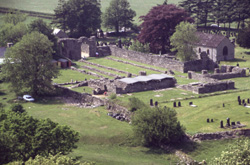 |
 |
 |
 |
 |
 |
 |
|
|
Cistercian Abbeys: STRATA FLORIDA Name: STRATA FLORIDA Location:
nr Tregaron County: Ceredigion In 1164 the Anglo-Norman lord, Robert fitz Stephen, founded Strata Florida Abbey on the banks of the River Fflur, on a site known today as yr hen fynachlog, which means ‘the old monastery’. The original site was colonised by a group of monks from Whitland. However, the following year Robert’s lands were over run by the Welsh lord, Rhys ap Gruffydd (d. 1197), prince of Deheubarth. Lord Rhys, as he was generally known, assumed patronage of Strata Florida and endowed the monastery with generous gifts. The original site of the monastery must have proved unsuitable, and some years later the community moved two miles north-east up the bank of the river Fflur. It is uncertain when exactly the monks moved to their new site but we know that construction of the permanent buildings must have been well under way by 1184, since in Lord Rhys’s charter of that year it was stated that he had ‘begun to build the venerable abbey entitled Stratflur’.(1) The abbey was consecrated in 1201 and the church was ready for the community to occupy the east end. However, construction work continued very slowly and the church and monastic buildings were not completed for another seventy years.(2) The abbey soon became a favourite of the Lord Ryhs and was cherished by the Welsh people. In 1238 Llewelyn the Great called all the native princes of Wales to meet at Strata Florida to swear allegiance to his son, David. During the twelfth and thirteenth centuries the abbey became wealthy on the riches produced by large scale sheep ranching. Lord Rhys had granted the abbey vast tracts of countryside ideally suited to the grazing of cattle and sheep. During its first twenty years the community had the numbers to send out two colonies to establish daughter-houses: Llantarnum (1179) and Aberconwy (1186). The abbey suffered several major set backs during the course of the thirteenth century. The abbey paid heavily for its loyalty to the Welsh and the wider cause of Welsh independence. In 1212 King John ordered his follower, Falkes de Breaute, to destroy the abbey ‘which harbours our enemies’.(3) The destruction of the abbey was prevented only when the abbot paid a heavy fine of 700 marks. The abbey had not long recovered from a devastating fire caused by lightening (in 1286) when it was set to flames once again. This time (in 1295) the royalist army were responsible, although it was apparently against the wishes of the king.(4) During the rising of Owain Glyndwr, at the beginning of the fifteenth century, the abbey was abandoned for some time and put under military occupation.(5) The abbey seems to have been a target during these unsettled times because it lay close to the main road that ran between Rhayader and the coast, and was thus easily accessible.(6) Despite such calamities the house became one of the national centres of Welsh literature and culture. The scholar and writer, Gerald of Wales, left his cherished library at the abbey, and it was at Strata Florida that the national annals of Wales, the Brut y Tywysogion or Chronicle of the Princes, were written.(7) The Red Book of Hergest, one of the Four Ancient Books of Wales, is also said to have been a Strata Florida manuscript or a copy of one.(8) Many famous Welsh writers and scholars were buried at Strata, including members of Dinefwr Abbey, and also the great medieval poet, Dafydd ap Gwilym.(9) By the sixteenth century the abbey's early wealth
had been eroded and the infirmary and refectory were already in
a state of ruin. At the time of the Dissolution the net annual
income of the house was valued at just £118.(10) The
house should then have been dissolved with the smaller monasteries
in 1536, however,
the abbey managed to avoid closure on payment of a large sum of
money. The house was finally suppressed four years later, in February
1539. By 1567 the property had been acquired by John Stedman, whose
family were to build the house which still stands over the area
to the south of the cloister.(11) The
site was later given to the church of Wales and in 1931 was placed
in the care of the government.
Today
the site is managed by Welsh Historic Monuments and the ruins,
which consist primarily of the church, the chapter-house and part
of the
cloister, can be visited at all reasonable times.
|
